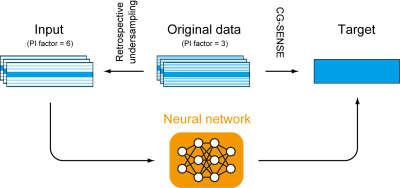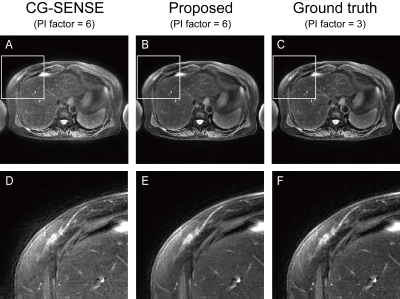1355
Fast abdominal T2 weighted PROPELLER using deep learning-based acceleration of parallel imaging
Motohide Kawamura1, Daiki Tamada1, Masahiro Hamasaki2, Kazuyuki Sato2, Tetsuya Wakayama3, Satoshi Funayama1, Hiroyuki Morisaka1, and Hiroshi Onishi1
1Department of Radiology, University of Yamanashi, Chuo, Japan, 2Division of Radiology, University of Yamanashi Hospital, Chuo, Japan, 3MR Collaboration and Development, GE Healthcare, Hino, Japan
1Department of Radiology, University of Yamanashi, Chuo, Japan, 2Division of Radiology, University of Yamanashi Hospital, Chuo, Japan, 3MR Collaboration and Development, GE Healthcare, Hino, Japan
Synopsis
Respiratory motion is a big problem in abdominal T2W imaging. PROPELLER sequence is an excellent solution for motion artifact. However, it requires longer acquisition than FSE, limiting its wider adoption in clinical situations. Here, we propose to use a deep learning-based parallel imaging reconstruction for accelerating PROPELLER. Our approach applies deep learning to the reconstruction of blade images. Thus, training is robust to respiratory motion because blade data can be obtained with single shot. Preliminary results showed that the proposed method significantly outperformed SENSE reconstruction.
Introduction
Fast spin-echo (FSE) technique is a standard pulse sequence for abdominal 2D T2 weighted (T2W) imaging. Since the efficiency of Cartesian sampling leads to fast acquisition, FSE is suitable as a routine clinical sequence. However, it suffers from respiratory artifacts including ghosts resulting from failure in the unfolding process of parallel imaging (PI). PROPELLER sequence overcomes this difficulty by sampling multiple blades.1 A propeller-like pattern consisting of the blades achieves signal averaging at the center of k-space, which results in robustness to respiratory motions. Longer scan times than FSE are considered to be the drawback of this technique, limiting the use in daily clinical practice. Recently, deep learning (DL) has attracted much attention in the field of accelerated MRI.2-4 Neural networks are trained using pairs of images with high and low sampling rate. Faster acquisition can be achieved by reducing sampling rate. Here, we propose to accelerate PROPELLER by increasing a PI factor for blade images using DL based reconstruction. A higher PI factor enables shorter scan times. One of the biggest challenges for DL based acceleration of abdominal T2W imaging is an influence of respiratory motions upon the quality of training images. The final image is reconstructed using multiple echo trains. Therefore, respiratory motions between multiple shots contaminate training data in typical DL frameworks where the final images with high sampling rates are target images. Our approach can mitigate this problem by using blade images as targets. Each blade image consists of single echo train. Considering the failure of respiratory triggering, the influence of respiratory motion within single shot is much smaller than between multiple shots. The aim of this study is to verify the feasibility of our method for acceleration of abdominal T2W PROPELLER.Methods
This study was approved by the institutional review board. Axial abdominal images were acquired from 191 patients on a 3 Tesla MRI scanner (SIGNA Premier, GE Healthcare, Waukesha, WI, USA) using anterior and posterior array coils. MR data acquisition was performed using a two-dimensional PROPELLER sequence with bellows-triggering. The whole trajectory consists of 10-13 blades. Each blade was acquired with single shot using the following parameters; phase encoding steps, 78; PI factor, 3; echo train length, 34.In our approach, input-target pairs were generated by retrospective undersampling as shown in Fig. 1. Input blade data with PI factor of 6 were obtained by undersampling original data with PI factor of 3. Target images were reconstructed from original blades using conjugate gradient SENSE (CG-SENSE).5 Coil sensitivity maps were estimated from the low frequency part of autocalibration signal lines.
We adopted MOdel-based reconstruction using Deep Learned priors (MoDL) proposed by Aggarwal et al. for PI reconstruction.6 Data from 32 patients were used for training, from other 8 for validation, and from the remaining 151 for test. A five layers convolutional neural network was used as a prior. We set the number of iterations as ten for the unrolled architecture. We used the averaged mean squared errors as loss function and performed Adam optimization. The other parameters were as follows; learning rate, 10-3; mini-batch size, 1. The final images were reconstructed from all blade data after PI reconstruction using the nonuniform fast Fourier transform (NUFFT) with density compensation.
The proposed method was compared to CG-SENSE for evaluation. PI reconstruction of blade data with PI factor of 6 was done using both methods. The final images after NUFFT were evaluated using peak signal-to-noise ratio (PSNR) and structural similarity (SSIM) index. The CG-SENSE result from data with PI factor of 3 was regarded as ground truth.
Results
The averaged PSNR of the images with the proposed method was 39.12 ± 1.42 dB, while that with CG-SENSE was 36.77 ± 1.26 dB (Paired t-test, P < 0.001). The averaged SSIM of the images with our method was 0.940 ± 0.013, while that with CG-SENSE was 0.934 ± 0.012 (Paired t-test, P < 0.001). Fig 2. shows an image from the test set. The result with CG-SENSE contains many noises due to the high PI factor. The proposed method successfully removes the noises, while keeping fine structures such as the bloods observed in the ground-truth image.Discussion
We proposed an accelerated PROPELLER using DL-based PI reconstruction. The retrospective study showed our approach significantly outperformed the conventional CG-SENSE, suggesting the possibility of PROPELLER sequence with short acquisition time comparable to that of Cartesian FSE.This preliminary result is based on retrospective undersampling. A prospective study is needed for detailed evaluation. Above all, it is important to assess the reduction of acquisition time. A reader study for subjective visual evaluation is also left for future study.
Conclusion
The proposed DL-based method accelerating PROPELLER sequence is a promising approach to enable motion-robust acquisition with reasonable scan times.Acknowledgements
No acknowledgement found.References
- Pipe JG. Motion correction with PROPELLER MRI: application to head motion and free-breathing cardiac imaging. Magn Reson Med. 1999;42(5):963-969.
- Hammernik K, Klatzer T, Kobler E, et al. Learning a variational network for reconstruction of accelerated MRI data. Magn Reson Med 2018; 79:3055–3071.
- Han Y, Yoo J, Kim HH, Shin HJ, Sung K, Ye JC. Deep learning with domain adaptation for accelerated projection-reconstruction MR. Magn Reson Med 2018; 80:1189–1205.
- Eo T, Jun Y, Kim T, Jang J, Lee HJ, Hwang D. KIKI-net: cross-domain convolutional neural networks for reconstructing undersampled magnetic resonance images. Magn Reson Med 2018; 80:2188–2201.
- Pruessmann KP, Weiger M, Börnert P, Boesiger P. Advances in sensitivity encoding with arbitrary k-space trajectories. Magn Reson Med. 2001;46(4):638-651.
- Aggarwal HK, Mani MP, Jacob M. MoDL: Model-Based Deep Learning Architecture for Inverse Problems. IEEE Trans Med Imaging. 2019;38(2):394-405.
Figures

Schemas of parallel imaging (PI) reconstruction of blade images for our accelerated PROPELLER. The neural network achieves a higher PI factor than the standard SENSE reconstruction, enabling faster acquisition.

Reconstructed images with CG-SENSE and the proposed method, and ground truth images. Compared to CG-SENSE, noises are reduced by the proposed method. (A) CG-SENSE, (B) the proposed method, (C) ground truth. (D)-(F) Magnified images of the solid boxes in (A)-(C), respectively.